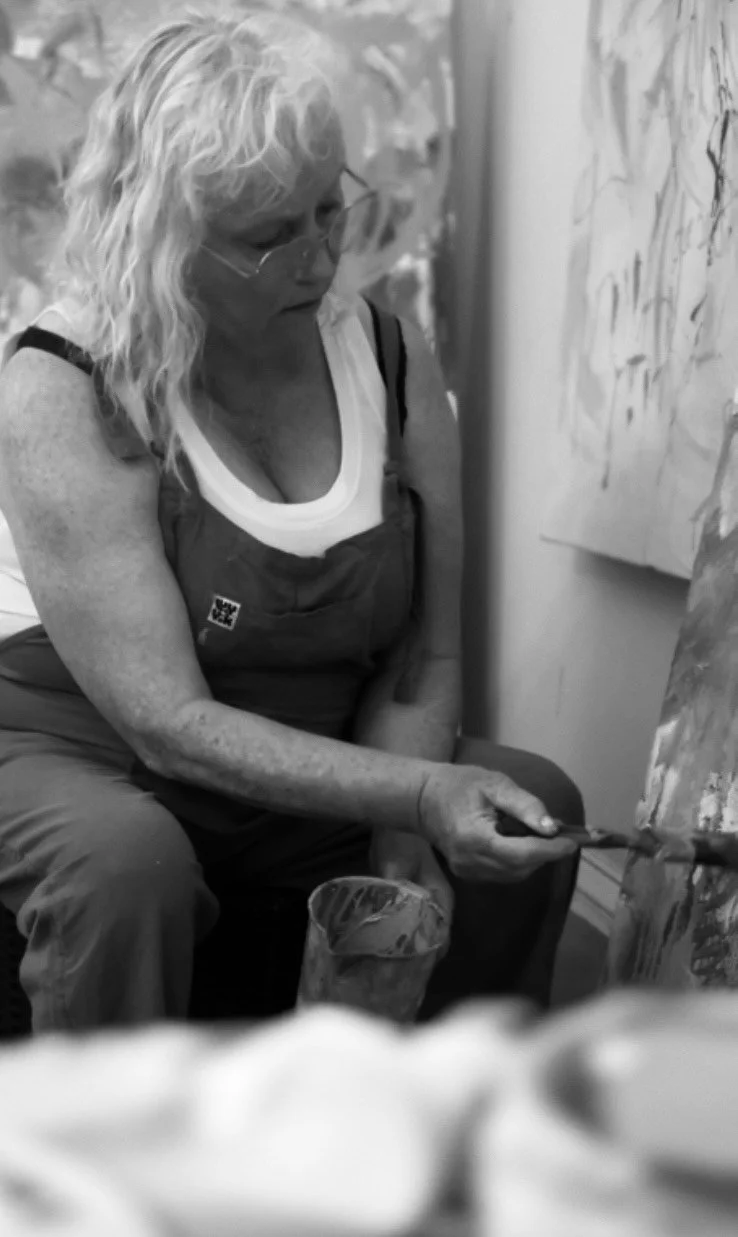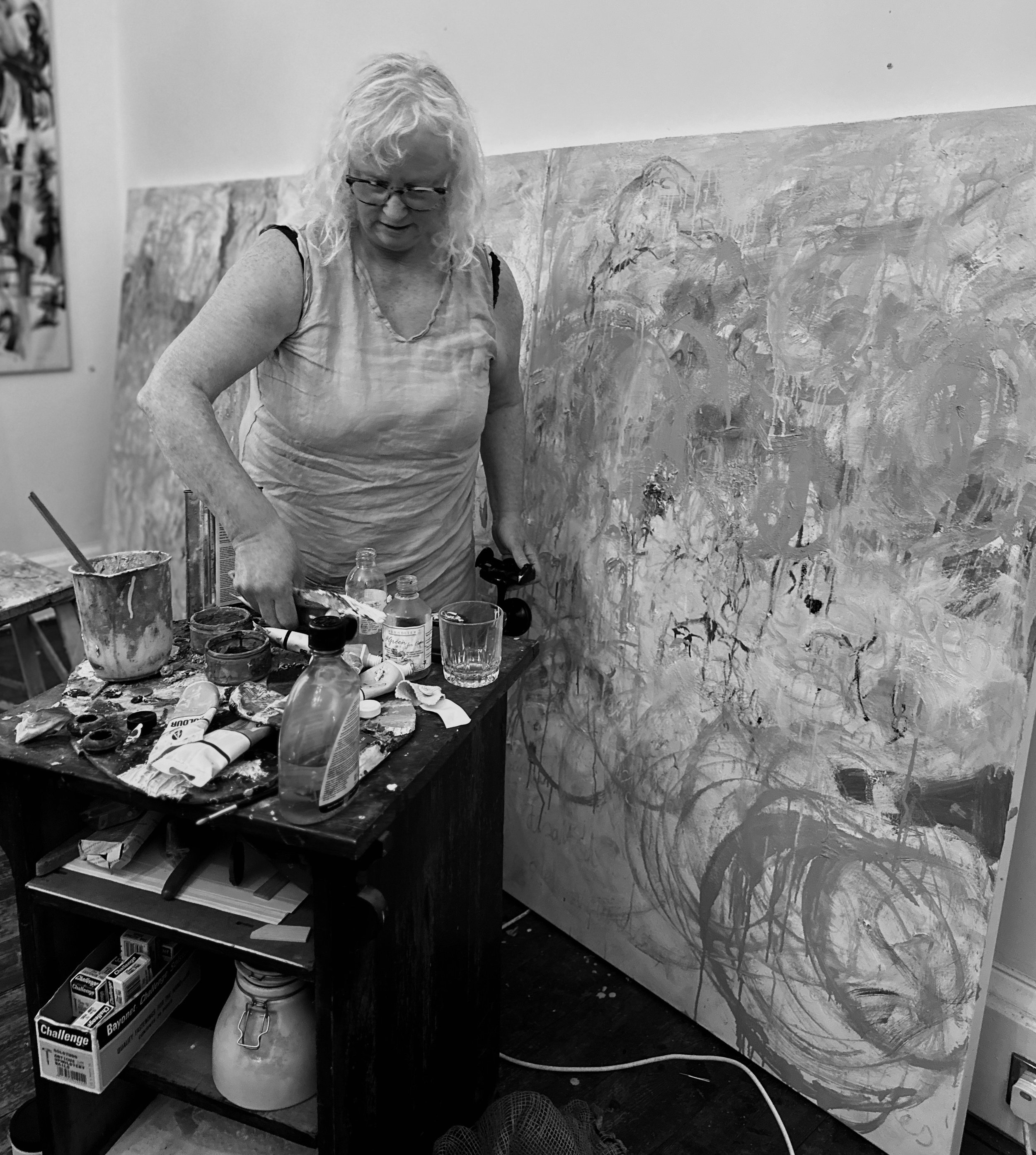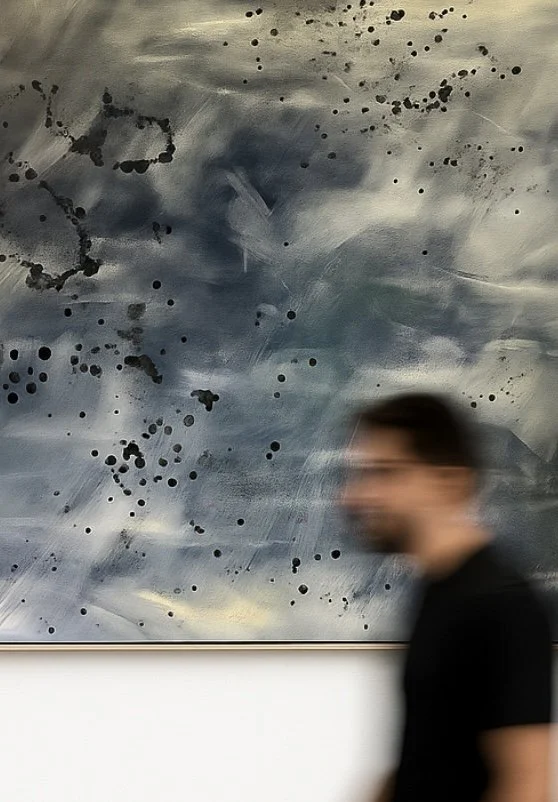Interview
Irene Watson
For more than thirty years, Irene Watson has operated at the crossroads of social practice, education, and contemporary art, collaborating with some of the most vulnerable communities to amplify lived experiences. Alongside this socially engaged work, Watson maintains a dedicated studio practice focused on painting, performance, and interdisciplinary inquiry. Primarily working with oil on canvas or linen, their studio pieces exhibit an allegorical approach that contemplates environmental fragility and human vulnerability. Recent bodies of work center on the “Pond” as a metaphor—a bounded yet expansive space through which ecological balance, conflict, and resilience are examined. The interplay of formal contrasts—figure and field, mark and landscape, harmony and dissonance—forms the foundation of these explorations, encouraging viewers to engage on both visual and conceptual levels.
Trained in the 1980s, Watson’s work is influenced by a continuum of modernist painters ranging from Cézanne to Franz Kline, while also recognizing the impact of groundbreaking female artists like Eva Hesse and Agnes Martin, who advanced new forms of expression within modernism. The fusion of text and image by artists such as Jenny Holzer and Tracey Emin has further shaped Watson’s approach, emphasizing a shift away from strict formalism toward a realm where color, gesture, and material presence convey social and political significance. Each series originates from thorough research yet embraces spontaneity and unpredictability in the creative process. Paint flows freely, surfaces develop through gestural movement, and meaning unfolds through the interplay between intention and material. These works invite viewers initially through their visual immediacy, encouraging a sustained engagement with themes of landscape, vulnerability, and emotional depth.
What is your background and how did you start your journey in the art world?
“I actually studied painting at Duncan of Jordanstone College of Art in Dundee — that was back in the ’80s — and then I went on to do an M.Phil in Public Art and Design. I’ve been working in the art world for over thirty years now, kind of sitting at the crossroads between social practice, education, and contemporary art. A lot of what I do is about working with communities, especially those who are often overlooked or vulnerable, and creating projects together that really let people share their own stories and experiences. At the same time, I’ve always kept my own studio practice going — painting’s still at the heart of it, but I love mixing it up with performance and other disciplines too.”
What inspires you?
“I mostly work in oils on canvas or linen, and I guess what really drives me is this ongoing fascination with how fragile the environment is — and how that ties in with our own human vulnerability. Lately, I’ve been really drawn to the idea of the pond as a kind of metaphor. It’s this small, self-contained space, but at the same time it feels vast — a whole world of balance, disruption, and resilience. In my paintings, I’m always playing with contrasts — figure and field, mark and landscape, harmony and dissonance — trying to find a visual rhythm that reflects those tensions.”
What themes do you pursue? Is there an underlying message in your work?
“Each series I make usually starts with a bit of research, but once I’m actually painting, it becomes about letting go a bit — allowing the process to take over. I love when paint behaves in unpredictable ways, when it flows or resists, and that dialogue between control and chance often shapes the meaning of the work. I want people to be drawn in by the surface — the colour, the texture — but then stay with it long enough to feel something deeper, to sense those connections between the landscape, fragility, and emotion.”
How would you describe your work?
“Well… I mostly work with oils on canvas or linen. My paintings tend to have this kind of… allegorical quality, I suppose — they’re reflections on how fragile the environment is, and on the ways we try to find balance with the world around us. Sometimes we manage it… and sometimes we don’t. Lately, I’ve been really drawn to the idea of the pond as a metaphor. It’s small and contained, but at the same time, it holds so much — it becomes a way of thinking about harmony, discord, resilience, care… all those shifting dynamics that run through both nature and life. I’ve always been interested in contrasts — figure against field, mark against landscape, moments of calm sitting right next to tension. Those relationships feel a bit like the push and pull of everyday living, really. When I’m working, I usually start with some research, but once I get going, I like to let things unfold. Paint has its own personality — it flows, it resists, it surprises you — and I enjoy responding to that. At its core, my work is about connection. I want people to be drawn in through colour and form, but also to stay with it — to feel something, to reflect a little on fragility, landscape, and emotion.”
Which artists influence you most?
“My influences stretch from modernist painters like Cézanne and Franz Kline to artists such as Eva Hesse, Agnes Martin, Jenny Holzer, and Tracey Emin — all of whom expanded the language of painting, text, and form in ways that continue to inspire me.”
“My paintings often carry an allegorical quality, reflecting on the fragility of the environment and the ways we balance (and sometimes fail to balance) with the world around us.”
What is your creative process like?
“I tend to work in series, and usually it all starts with a bit of research — just following an idea that catches my attention. But once I’m actually in the studio, I like to leave plenty of room for play… and for surprise. Paint has its own kind of life, you know? It flows, it resists, it leaves traces where you don’t expect them. I really try to listen to that — to let the material guide me rather than trying to control every outcome.”
What is an artist’s role in society and how do you see that evolving?
“I think an artist’s role is… to give voice to what’s hidden — to notice the things that usually go unseen or unspoken. It’s about paying attention to the overlooked corners of life and finding ways to bring them into view. And as the world keeps changing, I think that role only becomes more important — to slow things down, to reflect, and to remind people of what’s fragile, what’s human, and what still connects us.”
Have you had any noteworthy exhibitions you'd like to share?
“Well, I’ve spent much of my career working in partnership with others — and I’ve often been seen as a bit of an arts activist, I suppose. A lot of my work happens behind the scenes, helping to create space for other people’s voices to come through.
Over the years, I’ve collaborated with the Scottish Government and various NGOs to deliver multimedia arts projects with young people across Scotland — and some of that work has actually gone on to inform research at a political level, which is something I’m really proud of.
In terms of exhibitions, my work’s been selected for both the Royal Academy and the Royal Scottish Academy, and I’ve had solo shows at places like the Crawford Art Centre in St Andrews, the Meffan Institute, Greg Flint in Auckland, and the Drawing Room in Auckland as well. I also worked in partnership with LINLEY to deliver an exhibition in Pimlico, which was a really exciting collaboration.”
Instagram: @irene_watson_

















